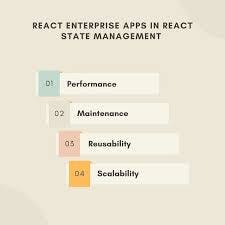React State Management...

React State Management enables entrepreneurs to create enterprise apps that are scalable, performant, and maintainable. However, various ways to effectively apply state management in ReacJS apps include component state, context API, React hooks, high-order components, and React state management libraries.
Although, the state management libraries in React have pre-built code bundles added to React front so that state management of components becomes easy. Thus, there are various states of React components, like global, fetch, UI state, etc., and each has its importance. In this blog, we have in-depth information about React State Management.
State management in React Enterprise Apps is necessary
The most important and challenging choice of the business owner is to make their enterprise apps in such a manner that is easy to maintain, reusable, delivers high performance, and, most important, is that an app must have a good scope of scalability.
React State Management is a well-known topic in the web development domain, and when you have a ReactJS enterprise app, getting in-depth knowledge is necessary. Let’s see how the state management React libraries enable your enterprise mobile app development to match your business goals.

1. Performance
ReactJS apps might have complexity loading during a frontend due to its re-renders. With React State Management, you can optimize your state updates, which gives better in-app performance and efficiency.
2. Maintenance
State Management in React applications that enable you to modularize and that will encapsulate the updates of states. Therefore, you can maintain and debug your codebase. Hence, this maintainability ensures that React app development team will rapidly adapt and understand an application’s state.
3. Reusability
Reusing the state across distinct components of React application isn’t easy. Still, using React state management libraries like Redux and MobX, you can share the states across all components f your application.
4. Scalability
The poor state management strategy leads to performance bugs and degradation, making it difficult to manage states as applications scale in size and complexity. React provides a well-designed state management strategy to sure that it will scale your ReactJS apps smoothly.
What are the different approaches in React to State Management?
ReactJS apps offer speed, flexibility, rich UI, and many more features. Find multiple ways to attain React state management to leverage a state of components in your application.
1. Component State
Each React component has its internal state that is used to store and manage data that is specific to that component. The state is controlled using a setState method that updates a component’s state and triggers a re-render.
2. Context API
The context API in React is an in-built way to share a state between the components in React without passing the data down the component tree via the props. Hence, it is a useful alternative to use a component state when you must share the state between components not directly connected in the component tree.
3. React hooks
It is how to include the state, and other React features in the functional components. The useState and useReducer hooks manage the local component state, while the useContext hook is utilized to access a shared state from Context API.
4. Custom Hooks
It is how to extract the state and logic into the reusable functions that multiple components use. Hence, it is a good option for sharing state and logic between the components not deeply nested in the component tree.
5. High-Order Components (HOCs)
HOCs are a way to share a state between the components by wrapping a component with another that provides the state. Hence, it is best to share the state between the components not profoundly nested in the component tree.
6. Render Props
Render props are the pattern transferred between components by passing the function as a prop that renders a component that requires a state. Hence, it is best for the components not deeply nested in the component tree.
Well-known React State Management Libraries
Some leading libraries are pre-built for state management in ReactJS apps.
1. Redux
It is a popular management library for web applications with Angular, React, and other frameworks. It gives a centralized store for managing the state of an application and has a set of rules for predictably modifying that state.
2. MobX
A state management library uses observables to track state changes, and it will automatically re-render components when those observables are modified. It is intuitive to use, has minimal boilerplate, has great performance, and is strongly compatible with React.
3. Recoil
Facebook developed Recxopi for React applications. It delivers the centralized storage to manage a state of an application and has a set of React hooks for accessing and updating the state. It is simple, flexible, and gives outstanding performance.
4. Jotai
Jotai uses atoms and setters to manage an application’s state, focusing on simplicity and performance. It works well with React and also has a small learning curve.
5. Zustand
Guillaume Salva developed the Zustand state management library for the React technology, and it uses the simplified Redux-like approaches to manage the state of an application. It has minimal boilerplate code, drives performance, and has a small bundle size. Hence, it is not suggested for complex state management handling.
6. Rematch
It is the Redux-based state management library for the React apps. It gives the simplified API for making Redux stores and reducers and hence reduces dependency on boilerplate and will improve developer productivity. It uses less boilerplate code than the traditional Redux and performs amazingly.
7. Hookstate
Hook state is the new state management library for React apps that Rafael Wieland created. Hookstate uses the simplified approach to manage an application’s state and will emphasize performance.
What are the different ReactJS States?
Here are the multiple ReactJS states defined below:
1. Local State
The state is certain to only one component and is managed using a setState method. It is usually used to store component-particular data only within that component.
2. Global State
It is shared between the various components and manages a whole application’s global data. It is saved in a centralized system, like the Redux store, and accessed by components via a store’s state.
3. Fetch State
It manages data fetched from a remote server or API. The fetch state is normally used to store data about a state of the fetch operation like the data has loaded, if there is an error, or if data is being loaded.
4. UI State
It manages data that affects how UI is displayed-data related to the user interface. The example of UI state makes the form visible, or the modal is open, currently selected tab or scroll position.
5. Server-side Caching State
It stores the state on the server and is used to cache data for React performance optimization. The server-side caching state is utilized to save the data that is not frequently modified, such as data about products or user profiles, to deduce the number of round trips to the server.
6. Mutable State
refers to data that can change over time and is typically stored in a component state using the useState hook or in the class component’s state. The mutable state is simple, like the string or number, or complicated, like the array or object. When the state updates, React will re-render the component and any child component which depends on that state.
7. Complex State
refers to the data derived from the other data and is usually not directly mutable. Rather than being stored in a state, a complicated state is calculated utilizing a component’s props and other state variables. Examples include calculation results, filtered or sorted versions of an array, or the current state of an animation. As the complicated state is not directly mutable, it does not trigger re-renders of the components when it modifies.
Conclusion
React state management is essential for entrepreneurs to make scalable, performant, and robust React applications. It keeps the application in sync with the user interface, as the in-built and third-party options handle and manage the state of React application. Hence, the wide range of solutions, your choice depends on the project requirements and your development team’s size.
1. Do you need state management in React apps?
React applications are created using the components and manage their state internally, and it works well for applications with some components. When the application grows larger, managing states shared across components becomes difficult.
2. What is state management pattern?
State management is the design pattern that aims to perfectly share the state data across React components and separate domain representation from state management. Hence, its pattern is applied by well-known web frameworks like Redux, Flux, or Vuex.
3. What is the need for state management techniques?
State management is the technique used to maintain the user and page information over the various requests while browsing the web. HTTP is a stateless protocol. Hence, it does not store any information about the user on a web page; the general need is for data to be maintained while navigating the website.
Prestical Software: Bringing Your Ideas to Life Through Custom Web and Mobile Apps
Prestical Software is a leading software development company specializing in crafting custom web and mobile applications that meet your unique needs and exceed your expectations. We are a team of passionate and experienced developers who are committed to helping businesses of all sizes achieve their goals through the power of technology.
What We Do
We offer a wide range of services, including:
Web App Development: We develop web applications that are tailored to your specific business needs, from simple e-commerce websites to complex enterprise applications.
Mobile App Development: We create iOS and Android apps that are engaging, user-friendly, and designed to drive results.
Software Consulting: We work with you to understand your business needs and recommend the best software solutions to help you achieve your goals.
Software Maintenance and Support: We provide ongoing maintenance and support for your web and mobile apps to ensure they are always up-to-date and running smoothly.
Why Choose Prestical Software?
There are many reasons why you should choose Prestical Software for your web and mobile app development needs:
Experience: We have over 10 years of experience developing web and mobile apps for a wide range of clients.
Expertise: Our team of developers is highly skilled and experienced in all the latest web and mobile technologies.
Customer Focus: We are committed to providing our clients with exceptional customer service and support.
Results-Oriented: We are focused on helping our clients achieve their business goals through the use of technology.
Contact Us Today
If you are looking for a reliable and experienced software development company to help you bring your ideas to life, contact Prestical Software today. We offer a free consultation to discuss your project and how we can help you achieve your goals.
In addition to the above, you may also want to consider including the following on your SEO page:
Case studies: Showcasing your successful projects can help build trust and credibility with potential clients.
Testimonials: Positive feedback from your clients can also be a powerful sales tool.
Blog: Regularly publishing informative and engaging blog posts can help you attract organic traffic and establish yourself as a thought leader in your industry.
Social media: Being active on social media can help you connect with potential clients and build brand awareness.
I hope this gives you a good starting point for creating an SEO page for Prestical Software. Please let me know if you have any other questions.
Please note that this is just a draft, and you may need to customize it to fit your specific needs. I recommend doing some keyword research to identify the terms that your target audience is searching for, and then incorporating those terms into your page content.
